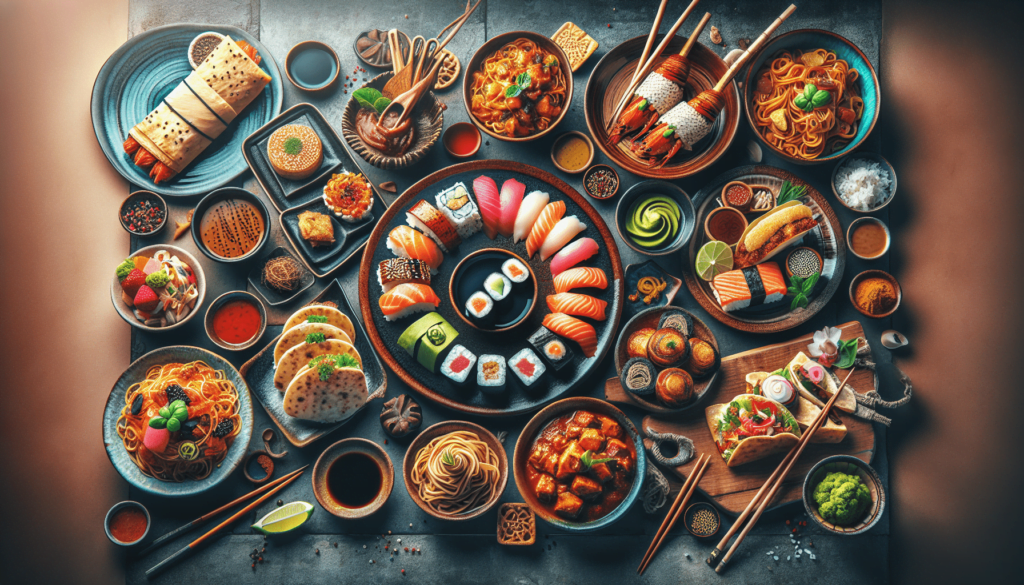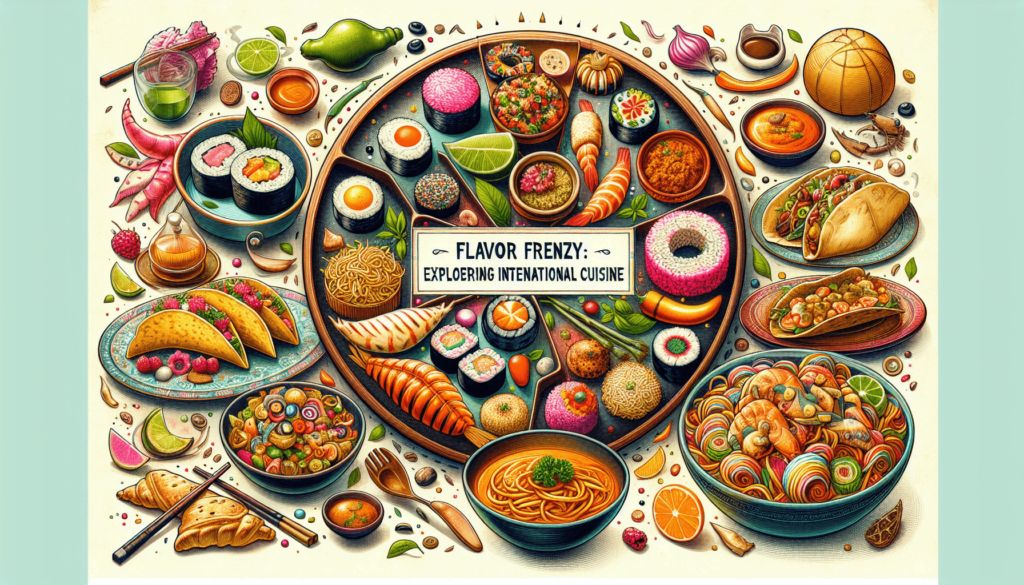Welcome to “Flavor Frenzy: Exploring International Cuisine,” where you’ll embark on a delicious journey across global culinary landscapes, discovering the rich tapestry of flavors that make up our world’s diverse food culture. Through a blend of historical background, current trends, and insightful analyses, this article unravels the enchanting evolution of international dishes, highlighting their origins and current influences.
Dive into detailed case studies and real-life examples that showcase the profound impact of globalization on our plates, offering a balanced perspective on varied culinary traditions and contemporary innovations. By the end of this flavorful exploration, you’ll gain a deeper appreciation for how international cuisines shape our gastronomic experiences and their implications for future culinary trends.
Have you ever wondered what makes the culinary traditions of different cultures so uniquely captivating? When we think about food from around the world, it’s more than just sustenance; it’s a tantalizing journey through history, geography, and culture. In this friendly exploration of international cuisine, we’ll dive into the rich tapestry of flavors that define our global culinary heritage.

Table of Contents
Overview
Food is a universal language that connects us all, transcending borders and offering a window into diverse cultures. From the spicy street foods of Thailand to the fragrant stews of Morocco, every dish tells a story. Understanding the origins and evolution of different cuisines not only excites our palates but also broadens our perspectives in a world that’s increasingly interconnected.
The relevance of exploring international cuisine has never been more significant. As we travel more, share more, and cook more diverse recipes at home, our curiosity about global flavors grows. This journey will take us through the historical contexts, current trends, key concepts, detailed explorations, and future directions of international cuisine.
Historical Context
The history of international cuisine is as old as civilization itself. Ancient trade routes like the Silk Road and the Spice Route played pivotal roles in the exchange of ingredients and culinary techniques. For instance, the use of spices in European cuisine can be traced back to these early interactions with Eastern traders, sparking a flavor revolution that shaped countless dishes.
The Silk Road and Culinary Exchange
This ancient network of trade routes connecting the East and West was instrumental in the spread of many ingredients that are staples in today’s global cuisines. From the introduction of rice in Persia to the spread of noodles from China, the Silk Road was a bustling thoroughfare for culinary innovation.
Colonial Influence
Colonialism further shaped the culinary landscape. European colonizers brought with them foods like potatoes and tomatoes from the New World, dramatically altering traditional diets. For example, Italian cuisine, famed for its tomato-based dishes, only adopted tomatoes after their introduction from the Americas.
Current Trends
Today, international cuisine is a melting pot of traditions, innovations, and fusions. Food trucks serving Korean-Mexican tacos, vegan adaptations of classic French dishes, and molecular gastronomy experiments are just a few examples of how global flavors are evolving.
Fusion Cuisine
Fusion cuisine blends elements from different culinary traditions to create innovative and exciting dishes. This trend reflects our growing multicultural societies and the curiosity of chefs and home cooks alike to experiment with new ingredients and techniques.
Sustainable and Ethical Eating
With increasing awareness about sustainability, there’s a growing trend towards sourcing ethical ingredients. This movement emphasizes local, seasonal produce and supports fair-trade practices, reflecting a broader shift towards responsible consumption.
Key Concepts and Definitions
Understanding international cuisine requires knowing some key concepts. Here are a few important terms that will help you navigate this flavorful journey:
- Umami: Often referred to as the fifth taste, umami is a savory flavor found in foods like soy sauce, mushrooms, and aged cheeses.
- Fermentation: A process that uses bacteria or yeast to transform the flavors and textures of food, common in many traditional cuisines, such as Korean kimchi and German sauerkraut.
- Sous-vide: A French culinary technique where food is cooked at a precise temperature in a water bath, often resulting in tender and flavorful dishes.
- Street Food: Foods that are typically sold by vendors on the street, providing affordable and accessible culinary delights common in many cultures.

Detailed Exploration
We will now break down the diverse world of international cuisine into several focus areas, each highlighting a unique aspect of global culinary traditions.
Flavor Profiling by Region
Asia: Spice and Variety
Asian cuisine is incredibly diverse, encompassing the fiery spices of Indian curries, the delicate flavors of Japanese sashimi, and the complex combinations found in Thai street food. The use of fresh herbs, spices, and unique cooking techniques, such as stir-frying and steaming, are hallmarks of this region.
- Indian Cuisine: Rich in spices like cumin, coriander, turmeric, and cardamom, Indian dishes often combine complex flavors with regional ingredients such as lentils, rice, and an array of vegetables and meats.
- Japanese Cuisine: Focuses on fresh, high-quality ingredients with a balance of flavors. Sushi, sashimi, and ramen are renowned for their meticulous preparation and presentation.
- Thai Cuisine: Known for its balance of five taste senses: sweet, sour, salty, bitter, and umami. Ingredients like lemongrass, galangal, and coconut milk create a harmonious blend in dishes like Tom Yum Goong.
Example 1: The Tapas Culture of Spain
Tapas, a variety of small dishes served in Spanish bars and restaurants, embody the social aspect of dining in Spain. Traditionally, tapas could include olives, cheeses, ham, and more complex dishes like Gambas al Ajillo (garlic shrimp).
- Historical Significance: Tapas evolved from the custom of serving a small piece of bread or meat with drinks to keep insects out of the glass.
- Modern Adaptations: Today, tapas have been embraced worldwide, often featuring local ingredients and creative twists.
Example 2: The Richness of Ethiopian Cuisine
Ethiopian cuisine is known for its rich, aromatic stews flavored with berbere spice mix and served on injera, a sourdough flatbread.
- Key Ingredients: Lentils, chickpeas, meats, and vegetables are common, with spices like ginger, garlic, and cumin playing a significant role.
- Cultural Importance: Meals are communal and often eaten with hands, emphasizing the importance of shared dining experiences.
Comparison of Different Perspectives
Let’s compare traditional and modern approaches to international cuisine.
Traditional vs. Modern
- Traditional Cuisine: Relies heavily on locally sourced, seasonal ingredients and time-honored cooking methods. It often involves labor-intensive processes passed down through generations.
- Modern Cuisine: Embraces technological advancements and global ingredient availability, facilitating innovation and fusion. Techniques like sous-vide cooking and molecular gastronomy are examples of modern influences.
Impact Assessment
Analyzing the impact of these differing perspectives reveals a multifaceted landscape where tradition and innovation coexist, enriching our culinary experiences.
Traditional Impact
Traditional cuisine preserves cultural heritage, offering insights into the history and lifestyle of a region. It fosters community and continuity, teaching us the origins and true nature of dishes.
Modern Impact
Modern culinary trends push the boundaries of creativity, expanding our palates and introducing us to new and exciting flavor combinations. They also promote sustainability and ethical consumption, adapting age-old practices to contemporary values.
Future Directions and Implications
What does the future hold for international cuisine? This dynamic field will likely continue evolving, influenced by globalization, technology, and changing societal values.
Predictions
- Increased Fusion Cuisine: As global boundaries blur, fusion cuisine will likely become even more diverse, combining flavors and techniques from multiple cultures.
- Technological Integration: Advances in cooking technology, such as 3D food printing, will introduce innovative ways of preparing and presenting food.
- Focus on Sustainability: The trend towards sustainable eating will become more pronounced, with increased emphasis on plant-based diets and ethical sourcing.
Implications
The continued evolution of international cuisine will have wide-ranging implications. It will enrich our cultural understanding, foster global connectivity, and promote healthier, more sustainable eating practices.
Conclusion
Recap
In our flavorful journey, we’ve explored the historical roots, current trends, key concepts, and future directions of international cuisine. You’ve learned about the historical significance of trade routes, the rise of fusion dishes, and the pivotal role of both traditional and modern culinary practices.
Final Thought
So next time you sit down to a meal, whether it’s a familiar favorite or a dish from a far-off land, remember that you’re partaking in a rich tapestry woven from centuries of culinary evolution. What story will your next meal tell?
Engagement
We’d love to hear about your own culinary adventures! Share your experiences with international cuisine in the comments below, explore more about the diverse world of food, and don’t hesitate to push your culinary boundaries.
Credible Sources
- Anderson, E. N. “Everyone Eats: Understanding Food and Culture.” NYU Press, 2005.
- David, Elizabeth. “Spices, Salt and Aromatics in the English Kitchen.” Penguin Books, 1970.
- Kiple, Kenneth F., and Coneè Ornelas. “The Cambridge World History of Food.” Cambridge University Press, 2000.
- Hall, Calvin S. “Food Culture in the Near East, Middle East, and North Africa.” Greenwood Press, 2008.
Embark on your own flavor frenzy and discover the delicious diversity that our world has to offer!
Exploring International Cuisine: A Journey Through Flavors and Traditions All Over The World!
